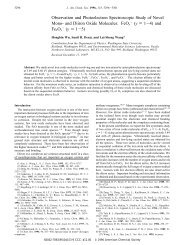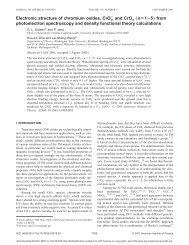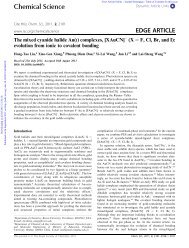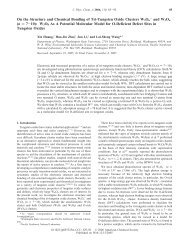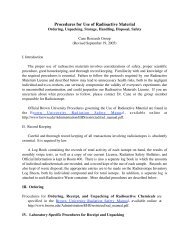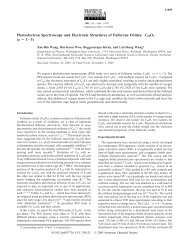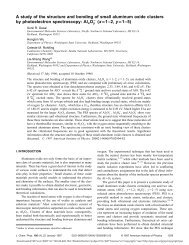Unique CO Chemisorption Properties of Gold Hexamer - Chemistry ...
Unique CO Chemisorption Properties of Gold Hexamer - Chemistry ...
Unique CO Chemisorption Properties of Gold Hexamer - Chemistry ...
You also want an ePaper? Increase the reach of your titles
YUMPU automatically turns print PDFs into web optimized ePapers that Google loves.
<strong>Unique</strong> <strong>CO</strong> <strong>Chemisorption</strong> <strong>Properties</strong> <strong>of</strong> <strong>Gold</strong> <strong>Hexamer</strong><br />
ARTICLES<br />
structure related to the C s isomer <strong>of</strong> the anion was found to be<br />
a low-lying isomer for neutral Au 6 (<strong>CO</strong>) 2 12, which is 0.67 eV<br />
higher in energy than the triangular structure 11. But the<br />
structure <strong>of</strong> this Au 6 (<strong>CO</strong>) 2 isomer is completely distorted, in<br />
which one Au-Au bond is broken, leading to the low symmetry<br />
C s ( 1 A′) structure 12. The chemisorption energy per <strong>CO</strong> in<br />
Au 6 (<strong>CO</strong>) 2- and Au 6 (<strong>CO</strong>) 2 decreases only slightly relative to the<br />
mono-<strong>CO</strong> chemisorbed systems (Table 3).<br />
4.4. Au 6 (<strong>CO</strong>) 3- and Au 6 (<strong>CO</strong>) 3 . Three anion structures (13-<br />
15) were identified for Au 6 (<strong>CO</strong>) 3 - , which are energetically<br />
degenerate at the B3LYP level and cannot be differentiated<br />
without accurate account <strong>of</strong> the dispersion electron correlation<br />
effects. Their corresponding neutral structures (16-18) were<br />
also identified as minima. However, in the neutrals, the<br />
triangular Au 6 -based structure C 3h ( 1 A′) is clearly the ground<br />
state (16), with the D 2h Au 6 -based structures (17 and 18) being<br />
0.75 and 0.34 eV higher, respectively. Note that structures 13<br />
and 16 are significantly different in the <strong>CO</strong> chemisorption<br />
angles. Structure 13 is derived from the ground-state structure<br />
<strong>of</strong> Au 6 (<strong>CO</strong>) 2 - (9) by adsorbing a <strong>CO</strong> to the third apex site. In<br />
structure 16, <strong>CO</strong> is almost collinear with one <strong>of</strong> the edges <strong>of</strong><br />
the triangular Au 6 , forming a propeller shaped C 3h structure.<br />
Structures 14 and 15 are derived from the D 2h isomers <strong>of</strong> Au 6<br />
-<br />
(2) with <strong>CO</strong> adsorbed at different positions. The chemisorption<br />
energy per <strong>CO</strong> in the triangular Au 6 (<strong>CO</strong>) 3 - (13) seemed to<br />
decrease slightly relative to that in Au 6 (<strong>CO</strong>) 2- , whereas in<br />
neutral Au 6 (<strong>CO</strong>) 3 the per <strong>CO</strong> chemisorption energy is nearly<br />
the same as that in Au 6 (<strong>CO</strong>) 2 (Table 3).<br />
5. Discussion<br />
Figure 5. Simulated photoelectron spectra for the ground-state structures<br />
<strong>of</strong> Au 6(<strong>CO</strong>) n - (n ) 0-3). The spectra were constructed by fitting the<br />
distribution <strong>of</strong> the calculated VDEs with unit-area Gaussian functions <strong>of</strong><br />
0.04 eV width.<br />
Table 3. Computed Average <strong>Chemisorption</strong> Energy per <strong>CO</strong> (in<br />
eV) in Au 6(<strong>CO</strong>) - n and Au 6(<strong>CO</strong>) n (n ) 1-3) a<br />
species B3LYP b,c PW91 c<br />
Au 6(<strong>CO</strong>) - 0.69 0.98 d , 1.14 e<br />
Au 6(<strong>CO</strong>)<br />
- 2 0.62 1.06 e<br />
Au 6(<strong>CO</strong>)<br />
- 3 0.47 0.92 e<br />
Au 6(<strong>CO</strong>) 0.61 0.89 d<br />
Au 6(<strong>CO</strong>) 2 0.56<br />
Au 6(<strong>CO</strong>) 3 0.53<br />
a All data are for optimized geometric structures based on the triangular<br />
Au 6 motif. b This work. c About 0.4-0.6 eV discrepancy between B3LYP<br />
and PW91 numbers was documented in ref 27. d From ref 27. e From ref<br />
28.<br />
to the ∠Au<strong>CO</strong> bond angle, which is 156.8° in the anion, but<br />
almost linear in the neutral structure. The D 2h Au 6 -based<br />
structure, 10 C s ( 2 A′), was found to be a low-lying isomer for<br />
Au 6 (<strong>CO</strong>) - 2 only 0.20 eV higher, where one <strong>CO</strong> adsorbs to a<br />
terminal site and the other on a bridging site. The neutral<br />
5.1. Comparison between the Experimental Data and<br />
Theoretical Calculations. The calculated ADEs for the groundstate<br />
transitions, i.e., the electron affinities for neutral Au 6 (<strong>CO</strong>) n<br />
(n ) 0-3), are compared to the experimental values in Table<br />
1. These values, computed from the differences between the<br />
total energies <strong>of</strong> the ground states <strong>of</strong> the anions and that <strong>of</strong> the<br />
neutrals, were all based on the triangular Au 6 . Excellent<br />
agreement was observed between the calculated and experimental<br />
ADEs. For Au 6 (<strong>CO</strong>) 3 - , there are three nearly degenerate<br />
structures competing for the ground state (Figure 4). However,<br />
only the triangular Au 6 -derived structure (13) yielded an ADE<br />
that agrees with the experiment. The ADEs calculated for the<br />
two structures derived from the D 2h Au 6 isomer (14, 15) were<br />
both much higher than the experimental value because the<br />
corresponding neutrals were found to be significantly higher in<br />
energy than the triangular structure (Figure 4). The calculated<br />
VDEs from the triangular Au 6 derived ground-state Au 6 (<strong>CO</strong>) n<br />
-<br />
(n ) 0-3) are also in excellent agreement with the experiment<br />
(Table 1).<br />
The computed reorganization energies are compared with the<br />
experimental values in Table 2. Excellent agreement was also<br />
observed. The relatively small values <strong>of</strong> the reorganization<br />
energies are consistent with the small geometrical changes<br />
between the anion and the neutral ground states from the<br />
triangular Au 6 derived complexes (Figures 2-4). The largest<br />
reorganization energy was for the three <strong>CO</strong> chemisorbed<br />
complex, largely due to the <strong>CO</strong> bond angle changes between<br />
the anion 13 and the neutral 16 (Figure 4).<br />
The calculated VDEs for the first excited state <strong>of</strong> neutral Au 6 -<br />
(<strong>CO</strong>) n (n ) 0-3) are also compared with the experimental<br />
J. AM. CHEM. SOC. 9 VOL. 127, NO. 34, 2005 12103



